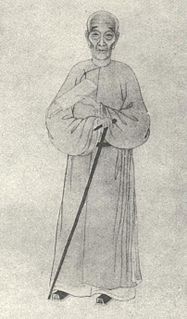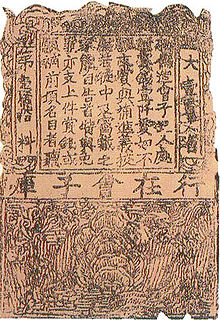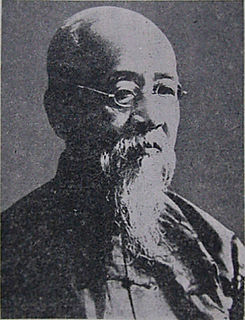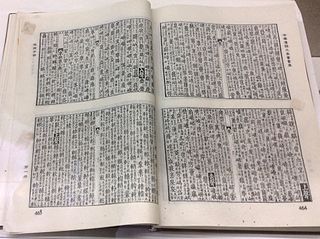
Duan Yucai (1735–1815), courtesy name Ruoying (若膺) was a Chinese philologist of the Qing Dynasty. He made great contributions to the study of Historical Chinese phonology, and is known for his annotated edition of Shuowen Jiezi.
King Yih of Zhou, personal name Ji Jian, was the seventh king of the Chinese Zhou Dynasty. Estimated dates of his reign are 899–892 BC or 899–873 BC.
In classical Chinese philology, shengxun or yinxun is the practice of explaining a character by using a homophone or near-homophone. The practice is ancient, and can be seen in pre-Qin texts. Xu Shen, author of the monumental Shuowen Jiezi, employed shengxun. For example, when Xu explained the word "ghost", he wrote:
人所歸爲鬼

Wang Niansun, courtesy name: Huaizu (懷祖) was a Chinese scholar of the Qing Dynasty.

Ganlu Zishu is a Chinese orthography dictionary of the Tang Dynasty. The first surviving orthographical dictionary for the regular script, it was authored by Yan Yuansun (顏元孫), a descendant of the famous scholar Yan Shigu. It is roughly based on Yan Shigu's work Ziyang, now surviving only in fragments. It was meant to be an official guide for the use of those who took the Imperial examination, thus the title "Ganlu", an allusion to the Analects (2:18).

Jiaozi was a form of promissory note which appeared around the 11th century in the Sichuan capital of Chengdu, China. Numismatists regard it as the first paper money in history, a development of the Chinese Song Dynasty. Early Jiaozi notes did not have standard denominations but were denominated according to the needs of the purchaser and ranged from 500 wén to 5 guàn. The government office that issued these notes or the Jiaozi wu demanded a payment or exchange fee of 30 wén per guàn exchanged from coins to banknote. The Jiaozi were usually issued biannually. In the region of Liang-Huai these banknotes were referred to as Huaijiao (淮交) and were introduced in 1136 but their circulation stopped quickly after their introduction. Generally the lower the denominations of the Jiaozi the more popular they became, and as the government initially wasn't able to properly regulate their production, their existence eventually lead to undesirably high rates of inflation.

The Huizi, issued in the year 1160, was the official banknote of the Chinese Southern Song dynasty. It has the highest amount of issuance among various banknote types during the Song dynasty. Huizi notes came on three-colour printed paper and their usage was heavily promoted by the government of the Southern Song dynasty, the Huizi were backed by 280,000 guàn of copper cash coins.

Luo Zhenyu or Lo Chen-yü, courtesy name Shuyun (叔蘊), was a Chinese classical scholar, philologist, epigrapher, antiquarian and Qing loyalist.

The Encyclopedia of China is the first large-entry modern encyclopedia in the Chinese language. The compilation began in 1978. Published by the Encyclopedia of China Publishing House, the encyclopedia was issued one volume at a time, beginning in 1980 with a volume on astronomy; the final volume was completed in 1993. It comprised 74 volumes, with more than 80,000 entries. Arranged by subject, which numbered 66, within each subject, entries were arranged by pinyin as many modern Chinese dictionaries have been. A Uyghur language edition was also published in 2015.
Fàn Zhěn was a Chinese philosopher, politician, and writer. He was an atheist of the Southern Qi Dynasty, remembered today for his treatise Shén Miè Lùn.
Nguyễn Thuyên or Hàn Thuyên was a 13th-century Vietnamese official and writer. According to Đại Việt sử ký toàn thư, in 1282, he composed a piece of writing, throwing it into the Red River to chase away a crocodile, similar to what the Tang Dynasty official and writer Han Yu once did. As a result, Emperor Trần Nhân Tông gave him the surname Hàn. He is known as the first one to compose Vietnamese poems in chữ Nôm, although his works did not survive. Following the Chinese model, he divided the six tones of Vietnamese into "flat" (平) and "sharp" (仄), and used this distinction as the metrical foundation of his poems. The poets after him followed this practice.

Manual of the Mustard Seed Garden, sometimes known as Jieziyuan Huapu (芥子園畫譜), is a printed manual of Chinese painting compiled during the early-Qing Dynasty. Many renowned later Chinese painters, like Qi Baishi, began their drawing lessons with the manual. It is an important early example of colour printing.

Longkan Shoujian is a Chinese dictionary compiled during the Liao Dynasty by the Khitan monk Xingjun (行均). Completed in 997, the work had originally been entitled Longkan Shoujing, but had its title changed owing to naming taboo when it was later printed by the Song publishers. The earliest surviving edition of the work is an incomplete Korean one, reprinted in China in 1985.

Sun Yirang was a Qing dynasty Chinese philologist. A native of Wenzhou, Zhejiang province, he retired from official employment early in his life to devote himself to scholarship. His most important works are Mozi Jiangu (墨子間詁), a corrected, definitive edition of Mozi, and Zhouli Zhengyi (周禮正義), an important commentary on the Rites of Zhou. He also contributed to the studies of the bronzeware script and oracle script. His work Qiwen Juli (契文舉例), published posthumously by Luo Zhenyu, was the first work of decipherment of the oracle bone script.
Kayue culture was a Bronze Age culture in Northwest China in the area of the upper reaches of the Yellow River and its tributary Huang Shui. It was discovered in 1923 in the villages Kayue (卡约) and Xiaxihe (下西河) of Yunguchuan Huangzhong in China's Qinghai Province and is named after the village of Kayue. The former name of the Kayue culture was Kayao culture, it was previously assigned to the Siwa culture. It is dated to the period of approximately 900 to 600 BCE.
The Huang-Ming Zuxun were admonitions left by the Hongwu Emperor Zhu Yuanzhang, the founder of the Chinese Ming dynasty, to his descendants. The text was composed in 1373 under the title Record of the Ancestor's Instructions; this was changed to Huang Ming Zu Xun during the publication of the 1395 edition.
The Dangyangyu Kiln was a private kiln in operation during the Northern Song dynasty, producing Cizhou ware. It is located in Xiuwu in Henan province, China, and is also known as the Xiuwu Kiln or Xiuwu kiln. Dangyangyu is sometimes presented as Tangyangyu, Tangyang Yu or Tang Yang Yu.

The guanzi, was a Song dynasty era form of paper money that served as promissory notes that could be traded for goods and services where the seller that received these notes could go to an issuing agency and redeem the note for strings of coins at a small exchange fee. They were originally introduced as a form of payment to the military at which time the notes were known as jianqian guanzi (見錢關子), and circulated alongside the contemporary jiaozi and huizi notes. After 1190 the records stop mentioning guanzi notes until 1264, an indication that jiaozi and huizi notes had superseded the guanzi in importance. From 1264 new guanzi notes were introduced such as the copper backed tongqian guanzi (銅錢關子), the silver backed yinguan (銀關), and the gold backed jinyin jianqian guanzi (金銀見錢關子), which were all introduced to combat the inflationary policy that had plagued the Huizi. The exchange rate between guanzi banknotes and copper cash coins was 1 guàn for 770 wén while huizi notes of the eighteenth production period were valued at 3 guàn for 1 wén. Despite these exchange rates the new guanzi banknotes did not stop the inflation that had plagued the Southern Song dynasty during its waning years. In the modern era not a single guanzi note survived regardless of the fact that many of them produced during the Southern Song era, in the modern era only the printing plates that were used to produce guanzi notes still exist and of the ten printing plates created by the Song government a total six are owned by the Administration Institute of Cultural Relics of Dongzhi County, two guanzi printing plates are in a private collection, and two of the printing plates have yet to be found.

The Da Ming Baochao was a series of banknotes issued during the Ming dynasty in China. They were first issued in 1375 under the Hongwu Emperor. Although initially the Da Ming Baochao paper money was successful, the fact that it was a fiat currency and that the government largely stopped accepting these notes caused the people to lose faith in them as a valid currency causing the price of silver relative to paper money to increase. The negative experiences with inflation that the Ming dynasty had witnessed signaled the Manchus to not repeat this mistake until the first Chinese banknotes after almost 400 years were issued again in response to the Taiping Rebellion under the Qing dynasty's Xianfeng Emperor during the mid-19th century.

The Simsim caves, also called the Caves of Senmusaimu, are decorated Buddhist caves in the area of Kucha, Tarim Basin, China. Other famous sites nearby are the Ah-ai Grotto, Kizil Caves, the Kizilgaha caves, the Kumtura Caves, and Subashi Temple.